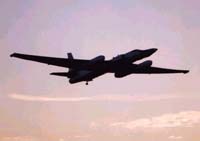| . |  |
. |
 Edwards - January 21, 2000 - NASA's Dryden Flight Research Center, has sent an Airborne Sciences ER-2 aircraft to the Yukon Territory of northwestern Canada in an effort to collect atmospheric samples from a meteor that exploded over the area at an altitude of 25 kilometers (15.6 miles) on January 18, 2000. The region, near the town of Carcross, is predominantly unpopulated.
Edwards - January 21, 2000 - NASA's Dryden Flight Research Center, has sent an Airborne Sciences ER-2 aircraft to the Yukon Territory of northwestern Canada in an effort to collect atmospheric samples from a meteor that exploded over the area at an altitude of 25 kilometers (15.6 miles) on January 18, 2000. The region, near the town of Carcross, is predominantly unpopulated.Samples of the debris cloud and vapor trail were gathered at an altitude of 65,000 feet with an instrument called the Aerosol Particulate Sampler (APS). The APS is a system of two small five-inch by four-inch paddles that deploy simultaneously from the ER-2's left wingtip. The paddles have silicone oil on them that, when exposed to the airstream for a sufficient amount of time, collect particles from the stratosphere. Then the paddles are withdrawn into hermetic enclosures to avoid contamination during the aircraft's return to Dryden. The paddles will be removed and sent to NASA's Johnson Space Center in Houston, Texas for analysis. Dryden's ER-2 also carried a camera, called the Dual RC-10, capable of taking black and white photos of eight-mile wide swaths of the region in an effort to locate any impact craters and other scarring of the earth, such as flattened areas of forest, that may have been caused by the explosion and impact of meteorites that separated from the meteor. Scientists are very interested in discovering the composition of the meteor in an effort to learn more about its origins and makeup. The Department of Defense is interested in knowing the composition of the meteor in order to calibrate sensors that detected the fireball. Collection of cosmic dust or meteorite samples would permit this. The meteor detonated with the energy of two to three kilotons of TNT. The extremely bright fireball was detected by defense satellites and recorded on seismic monitoring instruments. The meteor produced twin sonic booms and a sizzling sound over Alaska and northwestern Canada. The unexpected visitor ionized the atmosphere as it entered, leaving a glowing vapor trail that could be seen up to one and a half hours afterwards. Two bright green flashes were observed. A foul odor could be detected in the region in the hours following the event. On June 30, 1908, a huge explosion occurred in the sky above the central Siberian wilderness near the Tunguska River in Russia. The concussion from the blast, estimated at 20 megatons of TNT, leveled trees in an area nearly 40 miles in diameter. Oddly, the explosion produced no crater or other evidence of impact. Scientists at NASA and the University of Wisconsin conducted a computer simulation that strongly suggests that the Tunguska culprit was an asteroid, the most common class of meteorite. The simulation indicated that an asteroid about 100 feet in diameter and moving at a speed of 10 miles per second would disintegrate at a height of about five miles above the ground - approximately the same altitude at which the Tunguska object is believed to have exploded. Information gleaned from the January 18 meteorite in Canada might enhance understanding of the Tunguska event.
TERRADAILY.COM
|
| |||||||||
| The content herein, unless otherwise known to be public domain, are Copyright 1995-2016 - Space Media Network. All websites are published in Australia and are solely subject to Australian law and governed by Fair Use principals for news reporting and research purposes. AFP, UPI and IANS news wire stories are copyright Agence France-Presse, United Press International and Indo-Asia News Service. ESA news reports are copyright European Space Agency. All NASA sourced material is public domain. Additional copyrights may apply in whole or part to other bona fide parties. Advertising does not imply endorsement, agreement or approval of any opinions, statements or information provided by Space Media Network on any Web page published or hosted by Space Media Network. Privacy Statement All images and articles appearing on Space Media Network have been edited or digitally altered in some way. Any requests to remove copyright material will be acted upon in a timely and appropriate manner. Any attempt to extort money from Space Media Network will be ignored and reported to Australian Law Enforcement Agencies as a potential case of financial fraud involving the use of a telephonic carriage device or postal service. |